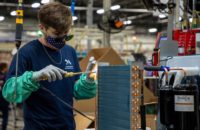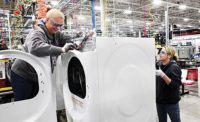In June, GE Appliances, a Haier company, announced plans to invest $115 million to expand its refrigerator assembly plant in Decatur, AL. The investment will add 255 new jobs to the plant, bringing the total number of full-time employees there to nearly 1,300.
The investment will boost production capacity by 25 percent to help GE Appliances meet rising demand for its top-freezer refrigerators.
The expansion is one of several major investments made by the business since becoming part of Haier two years ago. In 2018 alone, GE Appliances’ investments have included: $200 million to add 400 jobs and expand dishwasher and laundry production at the company’s flagship Appliance Park manufacturing campus in Louisville, KY; a $55 million expansion of a distribution center in northern Georgia; the opening of a $45 million expansion of a “smart” distribution center in Dallas; and a $10 million expansion of an assembly plant in Selmer, TN.
“Our $115 million investment in Decatur is a critical part of our plan to be the leading appliances business in the United States,” says Kevin Nolan, president and CEO of GE Appliances.
The facility is GE Appliances’ highest-volume refrigerator plant. It manufactures both GE and Hotpoint brand products. In 2016, the facility’s products were rated “No. 1 in quality and dependability,” according to an independent study by market research firm The Stevenson Co.
Recently, we spoke with plant manager Renee Story to talk about assembling refrigerators and how to encourage women to pursue manufacturing careers.
ASSEMBLY: You’ve been with GE Appliances since 1995. What made you stick around?
Story: I love manufacturing. It’s fast paced, it’s dynamic, it’s challenging. I love working with people, and I love being able to see the results of your efforts every day.
I received my bachelor’s degree in industrial engineering in 1994, and I began a technical leadership program with GE Appliances in 1995. The program encourages engineers to have an interest in manufacturing leadership.
During the two-year program, you rotate through four six-month assignments covering different facets of manufacturing and the supply chain. You change locations, as well. I was exposed to a variety of roles and experiences, and that really helped build my career. Since then, I’ve taken on various roles of increasing responsibility. GE Appliances is known for its training and development programs. We really believe in developing people.
ASSEMBLY: How do your operations now compare to what they were when you started?
Story: We have really focused on our operators. We design our products, build processes and workstations around them. They are experts at what they’re doing. They are out on the line making our product day in and day out. We tap their expertise for problem-solving and root-cause analysis.
In terms of technology, we have implemented robotics where it makes sense to improve efficiency, quality or safety. In manufacturing, there’s a lot of repetitive work, and unfortunately, that can lead to ergonomic issues. So we have automated those processes as much as we can.
Another technology that we’ve implemented recently is automatic guided vehicles (AGVs) for material handling.
ASSEMBLY: How are you using AGVs?
Story: One area where we use AGVs is door production. After a refrigerator door is fabricated, it gets injected with foam insulation. From there, it goes to an assembly area where parts such as gaskets and shelf fronts are installed. AGVs move the doors through fabrication, foaming and assembly. If we did not have the AGVs, the doors would have to be moved manually. It would involve a lot of personnel and a lot of walking.
Aside from being more efficient, the AGVs have improved quality. It’s important for refrigerator doors to have a cosmetic appearance. If you don’t have a consistent process for moving doors, you end up with a lot of damage. The AGVs prevent a lot of scrap and rework.
ASSEMBLY: That’s a good point. That’s another way of justifying automation, isn’t it?
Story: That’s true. The AGVs are good for ergonomics, too. With new material options, like slate and stainless steel, our doors are getting heavier. We don’t want to expose our workers to that.
I should add that we don’t foresee a time when robots completely take over our assembly lines. That’s not how we see the future. However, moving doors around is not a value-adding process, so that was a perfect opportunity for automation.
There are some assembly operations where you need a person. However, we also use technology to work in conjunction with people. For example, lift-assist devices help operators handle heavy parts, such as compressor assemblies.
ASSEMBLY: Congratulations on the expansion. What are your plans?
Story: This facility will become GE’s super site for top-mount refrigerators. We’re adding equipment to increase output, and we’re working to make changeovers seamless in our fabrication and foaming operations. We’re also adding another line shift.
We are using 3D scanning to help with tool qualification and problem solving.
Another initiative we’ve been working on is total productive maintenance (TPM). The new equipment we’re buying will have integrated sensors and vibration analysis to help prevent unexpected downtime. Operating equipment efficiency is really important.
We’re also improving our factory information systems so we can get production data as quickly as possible. We’ve made a lot of headway on that, but as we look to the future, we’re investigating how we can go further.
ASSEMBLY: Can you give me an example? What information are you looking for?
Story: Right now, on my smartphone, I can see our production rate. I can dig into various areas of the plant. I can get TPM data, so we can be proactive, instead of reactive, in maintaining equipment.
From a human resources standpoint, I can see who’s here and who’s not, so we can fill open jobs on the line because of absenteeism. Having all that information right on your phone or tablet is a very efficient way to manage vs. walking up and down a huge assembly plant.
The technology for smart boards and data visualization is moving so fast, I can’t predict where it’s going to lead. I can walk down our assembly line, stop by a workstation, and see how many times the andon cord was pulled and how long each stoppage was. We can use that information to see what aspects of the plant we need to work on.
I can get hourly production data. I can get quality and test yield data. There’s a lot of information at our fingertips to help us make the right decisions.
ASSEMBLY: In 2010, GE Appliances announced that the Decatur facility would be one of four “centers of excellence” for refrigeration design and manufacturing. Among other things, design teams would be co-located with operations to streamline product development and manufacturing. How is that working out?
Story: Traditionally, we were organized in functional silos. But our customers look at us from a horizontal perspective. They just want a finished product that works well, looks good, and is delivered on time. Co-locating design and operations has helped us achieve the best overall outcomes. It allows us to have conversations about safety and quality, and it has enabled us to make decisions quickly. A design engineer can ask, “If we change this dimension or if we make the part a different shape, could we assemble it?”
If the design engineer is in Louisville and the manufacturing engineer is in Decatur, that conversation becomes more difficult.
ASSEMBLY: What needs to be done to help more women achieve management positions in manufacturing—and to encourage women to pursue manufacturing careers?
Story: There needs to be more outreach. Here at GE Appliances, we host STEM programs for local schools. Students visit our facility and see how clean it is and how high-tech it is. Unfortunately, many people have this not-so-great perception of manufacturing.
In 2016, I was one of several women in manufacturing to receive a STEP Ahead award from the National Association of Manufacturers. STEP stands for science, technology, engineering and production. That award was started to create a group of women who could help other women pursue manufacturing career paths.
GE Appliances has done a nice job of encouraging women to pursue manufacturing careers. In fact, Bill Good, our vice president of supply chain, was recently named to the board of directors of Women in Manufacturing, a national trade association dedicated to supporting women who have chosen careers in manufacturing. He understands the importance of having a diverse workforce. You get a lot more new ideas with a diverse workforce.
ASSEMBLY: It’s been two years since GE Appliances became part of Haier. Have you learned things from each other?
Story: We have learned a lot. We share the same priorities, and we are very much focused on supporting our U.S. manufacturing sites and investing in the future. It’s been great to be part of a company that is solely focused on making appliances and making them better.
I’m part of Haier’s global supply chain manufacturing committee, which meets monthly to share best practices among all of Haier’s plants worldwide. What can we learn from each other? If I’m trying to resolve a problem at my plant, chances are good someone else has run into something similar. Haier has a tremendous amount of knowledge and experience at its facilities worldwide.





